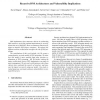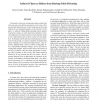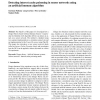34 search results - page 3 / 7 » Poisoning the Kad Network |
P2P
2009
IEEE
14 years 16 days ago
2009
IEEE
A Distributed Hash Table (DHT) is a structured overlay network service that provides a decentralized lookup for mapping objects to locations. In this paper, we study the lookup pe...
NDSS
2009
IEEE
14 years 16 days ago
2009
IEEE
DNS implementers face numerous choices in architecting DNS resolvers, each with profound implications for security. Absent the use of DNSSEC, there are numerous interim techniques...
ACSAC
1999
IEEE
13 years 10 months ago
1999
IEEE
This paper discusses the Address Resolution Protocol (ARP) and the problem of ARP cache poisoning. ARP cache poisoning is the malicious act, by a host in a LAN, of introducing a s...
NDSS
2006
IEEE
13 years 11 months ago
2006
IEEE
Structured overlays are an important and powerful class of overlay networks that has emerged in recent years. They are typically targeted at peer-to-peer deployments involving mil...
APIN
2010
13 years 6 months ago
2010
The objective of this paper is to investigate how a Danger Theory based Artificial Immune System--in particular the Dendritic Cell Algorithm (DCA) can detect an attack on a sensor ...



